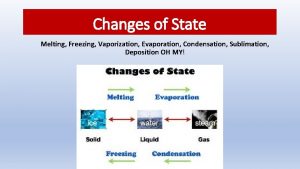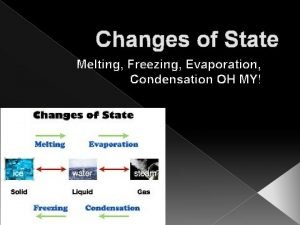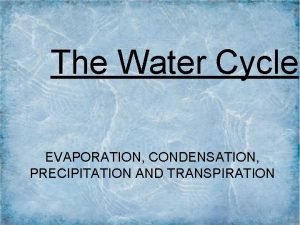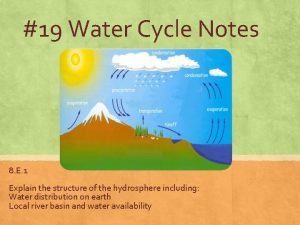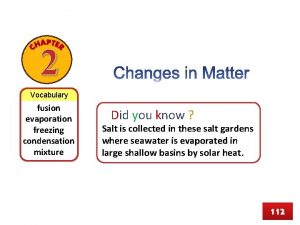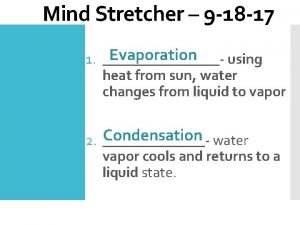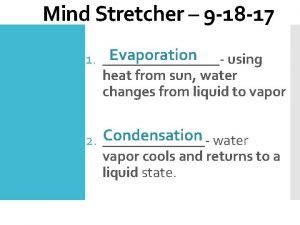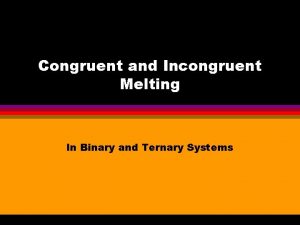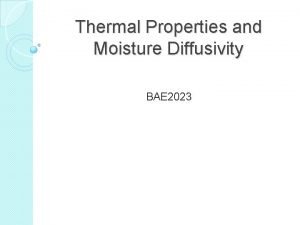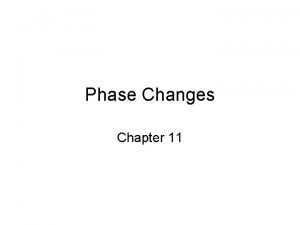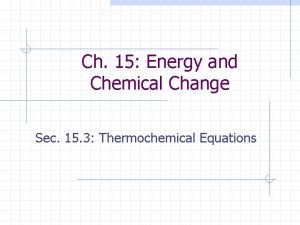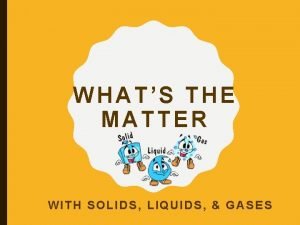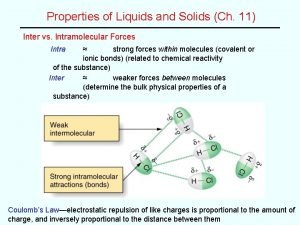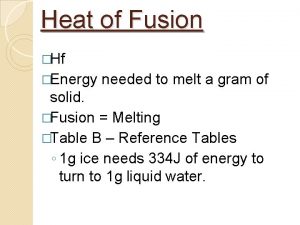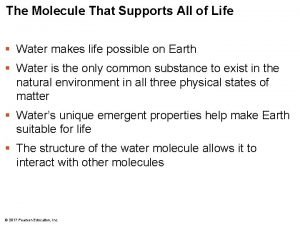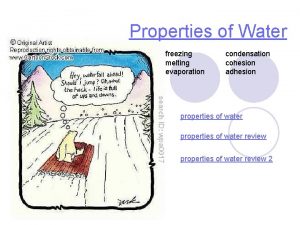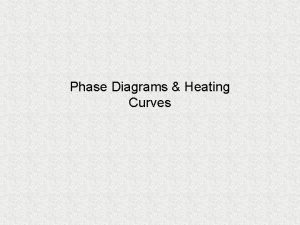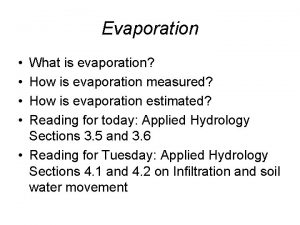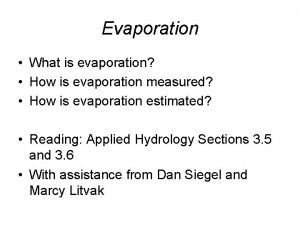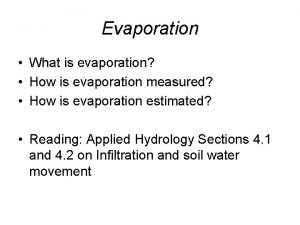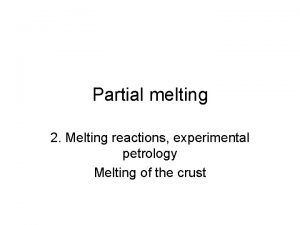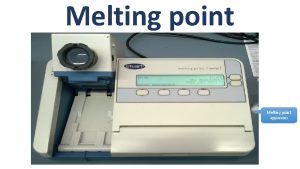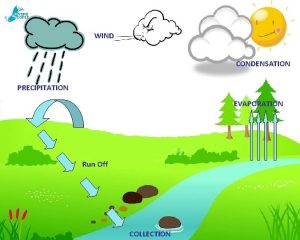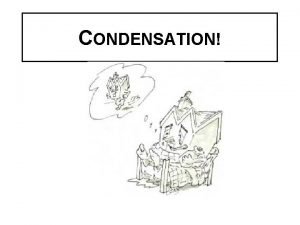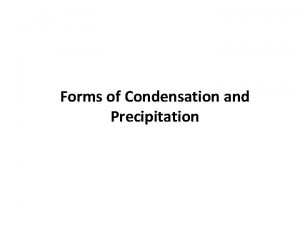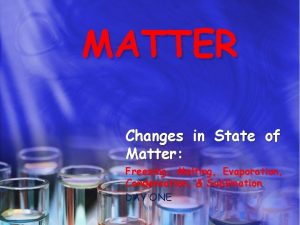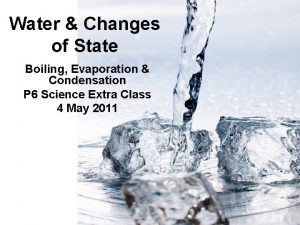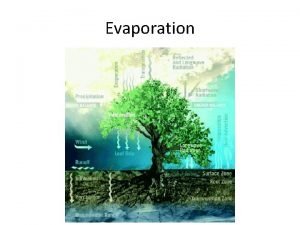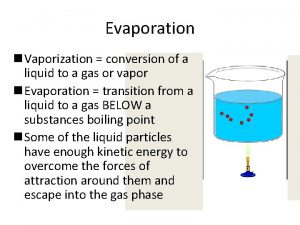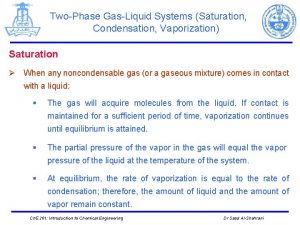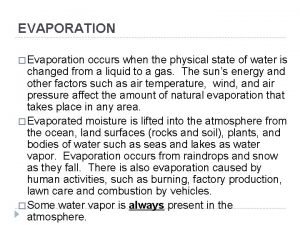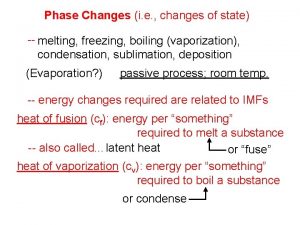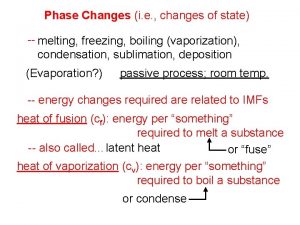Changes of State Melting Freezing Vaporization Evaporation Condensation

























- Slides: 25

Changes of State Melting, Freezing, Vaporization, Evaporation, Condensation, Sublimation, Deposition OH MY!

Learning Objectives • I can describe the 6 changes of state (melting, freezing, vaporization, condensation, sublimation, and deposition) in terms of what happens to the energy and spacing of the particles. • I can describe the differences between endothermic and exothermic changes of state.


What is a change in state or phase change? • A change of state is changing a substance from one physical form to another. • Phase Change – A reversible physical change that occurs when a substance changes from 1 state to another. • Physical change means the substance only changes it’s appearance; it’s still the same substance!

How do substances change state? • A substance can change from one state to another by adding or removing ENERGY! • One type of energy is HEAT…so we are adding heat or removing heat to change states

What happens when you add energy…heat? • The more energy/heat (higher temperature) will make the particles move faster. • The more energy/heat will make the particles spread out more and attraction decreases.

Temperature • Temperature – the measure of particles moving (speed) and therefore a measure of it’s energy. - Higher temperatures = Fast moving particles - Lower temperatures = Slow moving particles.

Types of Energy Changes • Endothermic – Heat goes INTO an object from its surroundings. • Exothermic – Heat is RELEASED from an object to the surroundings.

What are the changes in state? • Melting • Vaporization • Sublimation • Freezing • Condensation • Deposition Energy is absorbed - Endothermic Energy is released - Exothermic

Change of state: MELTING • Melting: The change of a solid to a liquid. • Energy (HEAT) must be added to the substance to make it melt. • Endothermic

Melting… • As the substance is melting, the particles are moving faster because energy/heat was added. • The particles are also spreading out more because the attraction is less and they are going from a solid (packed together) into a liquid (loosely packed)

Change of state: Vaporization • Vaporization: The change of a liquid to gas. • Energy/heat must be added to make it evaporate • Endothermic

Vaporization…. • The particles are moving even faster as they go from a liquid to a gas • The particles are spreading out farther and attraction is decreasing.

Change of state: SUBLIMATION • Sublimation: The change of a solid directly to a gas. • Energy must be added. • Think: As dry ice is exposed to a warmer temperature (more energy) it will begin to look like its steaming. • Particles are moving faster as the solid turns into a gas • Endothermic • Example: Dry ice

Reverse • REVERSE!

What happens when you remove energy…heat? • If you remove energy/heat (lower temperature) the particles move slower • The less energy/heat will make the particles move together more and attraction increases.

Change of state: FREEZING • Freezing: The change of a liquid to a solid. • Energy/heat must be removed to make the substance freeze. • Exothermic

Freezing…. • As energy/heat is removed and the substance is freezing, the particles are starting to move slower. • As energy/heat is removed to freeze, the particles are getting closer and attraction is increasing.

Change of state: CONDENSATION • Condensation: The change of a gas to a liquid. • Energy/heat must be removed to change a gas to a liquid. • Exothermic • Example: All the steam from a hot shower creates condensation (water droplets) on the mirror.

Condensation… • As energy/heat is removed in condensation, particles are moving slower. • As energy/heat is removed in condensation, the particles get closer and the attraction increases.

Change of state: Deposition • Deposition: The change of a gas directly to a solid. • Energy must be removed (taken away). • Particles are moving slower as the gas turns into a solid • Exothermic • Example: Frost on windows

Wrap up!

Energy is absorbed - Endothermic Energy is released - Exothermic

Phase Changes Phase Change Melting Freezing Vaporization Condensation Sublimation Deposition Phase to Phase Ex. Solid to Gas Solid to Liquid to Solid Liquid to Gas to Liquid Solid to Gas to Solid Endothermic or Exothermic? Endothermic Exothermic

Points Where Phase Changes Occur • Melting Point – Temperature at which a solid turns to a liquid. • Freezing Point -Temperature at which a liquid turns to a solid. • Boiling Point -Temperature at which a liquid turns to a gas. • Condensation Point - Temperature at which a gas turns to a liquid.
 Examples of phase change
Examples of phase change Vaporization particles
Vaporization particles Melting freezing boiling evaporation condensation
Melting freezing boiling evaporation condensation Evaporation condensation precipitation transpiration
Evaporation condensation precipitation transpiration Condensation evaporation precipitation
Condensation evaporation precipitation Fusion evaporation condensation
Fusion evaporation condensation Prep 1
Prep 1 Evaporation mind map
Evaporation mind map Congruent melting point
Congruent melting point Unit of thermal diffusivity is
Unit of thermal diffusivity is Specific latent heat formula
Specific latent heat formula Is vaporization endothermic or exothermic
Is vaporization endothermic or exothermic Heating cooling curve
Heating cooling curve Chapter 15 energy and chemical change
Chapter 15 energy and chemical change Vaporization matter
Vaporization matter Vaporization matter
Vaporization matter Heat fusion formula
Heat fusion formula Elizabeth mulroney
Elizabeth mulroney Example of a chemical change
Example of a chemical change Change in state of matter
Change in state of matter Lesson 6 changes of state answer key
Lesson 6 changes of state answer key Cool chilly cold freezing
Cool chilly cold freezing Donate eggs nashville
Donate eggs nashville Expansion upon freezing
Expansion upon freezing Expansion upon freezing
Expansion upon freezing Time out freezing in mobile computing
Time out freezing in mobile computing

